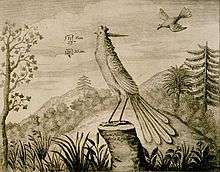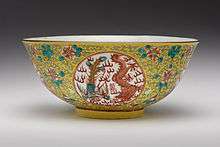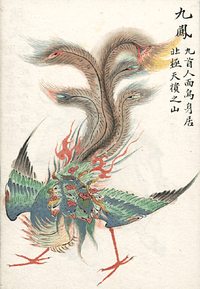Fenghuang
| Fenghuang | |||||||||||||||||||||||||||||
 | |||||||||||||||||||||||||||||
| Chinese name | |||||||||||||||||||||||||||||
|---|---|---|---|---|---|---|---|---|---|---|---|---|---|---|---|---|---|---|---|---|---|---|---|---|---|---|---|---|---|
| Simplified Chinese | 凤凰 | ||||||||||||||||||||||||||||
| Traditional Chinese | 鳳凰 | ||||||||||||||||||||||||||||
| |||||||||||||||||||||||||||||
| Vietnamese name | |||||||||||||||||||||||||||||
| Vietnamese alphabet | phượng hoàng / phụng hoàng | ||||||||||||||||||||||||||||
| Korean name | |||||||||||||||||||||||||||||
| Hangul | 봉황 | ||||||||||||||||||||||||||||
| Hanja | 鳳凰 | ||||||||||||||||||||||||||||
| |||||||||||||||||||||||||||||
| Japanese name | |||||||||||||||||||||||||||||
| Kanji | 鳳凰 | ||||||||||||||||||||||||||||
| Hiragana | ほうおう | ||||||||||||||||||||||||||||
| |||||||||||||||||||||||||||||
Fenghuang (simplified Chinese: 凤凰; traditional Chinese: 鳳凰; pinyin: fènghuáng; Wade–Giles: fêng4-huang2) are mythological birds of East Asia that reign over all other birds. The males were originally called feng and the females huang but such a distinction of gender is often no longer made and they are blurred into a single feminine entity so that the bird can be paired with the Chinese dragon, which is traditionally deemed male.
The fenghuang is also called the "August Rooster" (simplified Chinese: 鹍鸡; traditional Chinese: 鶤雞 or 鵾雞; pinyin: yùnjī or kūnjī; Wade–Giles: yün4-chi1 or k'un1-chi1) since it sometimes takes the place of the Rooster in the Chinese zodiac. In the West, it is commonly called the Chinese phoenix or simply Phoenix, although mythological similarities with the Western phoenix are superficial.
Appearance

A common depiction of fenghuang was of it attacking snakes with its talons and its wings spread. According to the Erya's chapter 17 Shiniao, fenghuang is made up of the beak of a rooster, the face of a swallow, the forehead of a fowl, the neck of a snake, the breast of a goose, the back of a tortoise, the hindquarters of a stag and the tail of a fish.[1] Today, however, it is often described as a composite of many birds including the head of a golden pheasant, the body of a mandarin duck, the tail of a peacock, the legs of a crane, the mouth of a parrot, and the wings of a swallow.
The fenghuang's body symbolizes the celestial bodies: the head is the sky, the eyes are the sun, the back is the moon, the wings are the wind, the feet are the earth, and the tail is the planets.[2] The fenghuang is said to have originated in the sun.[2] Its body contain the five fundamental colors: black, white, red, yellow, and green.[2] It sometimes carries scrolls or a box with sacred books.[2] It is sometimes depicted with a fireball.[2] It is sometimes depicted as having three legs. It is believed that the bird only appears in areas or places that are blessed with utmost peace and prosperity or happiness.
Chinese tradition cites it as living atop the Kunlun Mountains in northern China.
Origin

Images of an ancient bird have appeared in China for over 8000 years, as earliest as the Hongshan neolithic period, on jade and pottery motifs, then appearing decorating bronze as well as jade figurines. Some believe they may have been a good-luck totem among eastern tribes of ancient China.
During the Han dynasty (2,200 years ago) two phoenixes, one a male (feng, 鳳) and the other a female (huang, 凰) were often shown together facing one other. Later, during the Yuan dynasty the two terms were merged to become fenghuang, but the "King of Birds" came to symbolize the empress when paired with a dragon as a dragon represented the emperor. From the Jiaqing era (1522–66) of the Qing dynasty onwards, a pair of phoenixes was differentiated by the tail feathers of the two birds, typically together forming a closed circle pattern—the male identified by five long serrated tail feathers or "filaments" (five being an odd, masculine, or yang number) and the female by what sometimes appears to be one but is in fact usually two curling or tendrilled tail feathers (two being an even, feminine, or yin number).
Also during this period, the fenghuang was used as a symbol representing the direction south. This was portrayed through a male and female facing each other. Their feathers were of the five fundamental colors: black, white, red, green, and yellow. These colors are said to represent Confucius' five virtues:
- Ren: the virtue of benevolence, charity, and humanity;
- Yi: honesty and uprightness; Yì may be broken down into zhong, doing one's best, conscientiousness, loyalty and shù: the virtue of reciprocity, altruism, consideration for others
- Zhi: knowledge
- Xin: faithfulness and integrity;
- Li: correct behavior, propriety, good manners, politeness, ceremony, worship.[3]
The phoenix represented power sent from the heavens to the Empress. If a phoenix was used to decorate a house it symbolized that loyalty and honesty were in the people that lived there. Or alternatively, a phoenix only stays when the ruler is without darkness and corruption (政治清明).
Meaning


The fenghuang has very positive connotations. It is a symbol of high virtue and grace. The fenghuang also symbolizes the union of yin and yang. Shan Hai Jing's 1st chapter “Nanshang Jing” records each part of fenghuang's body symbolizes a word, the head represents virtue (德), the wing represents duty (義), the back represents propriety (禮), the abdomen says credibility (信) and the chest represents mercy (仁).[4]

In ancient and modern Chinese culture, they can often be found in the decorations for weddings or royalty, along with dragons. This is because the Chinese considered the dragon and phoenix symbolic of blissful relations between husband and wife, another common yang and yin metaphor.

In some traditions it appears in good times but hides during times of trouble, while in other traditions it appeared only to mark the beginning of a new era.[5] In China and Japan it was a symbol of the imperial house, and it represented "fire, the sun, justice, obedience, and fidelity".[5]
Modern usage
- When describing chinoiserie or authentic Asian ceramics and other artworks, English-speaking art historians and antique collectors sometimes refer to it as hoho bird,[6] a name derived from hō-ō, with a second extraneous h added. Hō-ō is simply the Japanese pronunciation of fenghuang. The seemingly vast difference between hō-ō and fenghuang is due to Chinese vowels with ng usually being converted to ō in Go-on reading. The Japanese also use the word fushichō for this image.
- Phoenix talons (S:凤爪 T:鳳爪) is a Chinese term for chicken claws in any Chinese dish cooked with them.
- Fèng or Fènghuáng is a common element in given names of Chinese women (likewise, "Dragon" is used for men's names).
- "Dragon-and-phoenix infants" (S:龙凤胎 T:龍鳳胎) is an expression meaning a set of male and female fraternal twins.
- Fenghuang is a county in western Hunan, southern China, formerly a sub-prefecture. Its name is written with the same Chinese characters as the mythological bird.
- In Korea, this bird is known as Bong Hwang 봉황, this merely being the Korean pronunciation of fenghuang. An alternate term of Bul Sa Jo 불사조 (不死鳥), or "immortal bird" is used to refer to the type of phoenix that never dies (i.e. the Greek "phoenix"), with bong hwang being reserved for the Asian variety. Bong Hwang is often seen used within the royal emblem (especially for queens - the dragon being the emblem of the king) and appears twice in the current presidential emblem. North Jeolla's football club uses it as its symbol.
- The Vermilion Bird, (Suzaku in Japanese) one of the Four Symbols of Chinese myth, sometimes confused with the fenghuang, from which it is a distinct entity.[7]
- Phoenix Television (鳳凰衛星電視) is a Hong Kong-based media company
- Typhoon Fung-wong has been a meteorological name for three tropical cyclones. The term was contributed by Hong Kong and is the Cantonese pronunciation of fenghuang.
Sculpture by the S. Korean Presidential Residence.
 Seal of the South Korean President, with twin phoenix emblem.
Seal of the South Korean President, with twin phoenix emblem.
See also

- Chinese dragon
- Chinese mythology
- Hōō-dō, Buddhist temple in Japan
- Fenghuang Ancient City
- Korean dragon
- Japanese dragon
- Ho-oh (Pokémon)
- Huma (Persian myths)
- Phoenix (manga)
- Phoenix (mythology)
- Phoenix Program, Vietnam War operation by the US
- Phoenix Mountain, a mountain in Zhejiang province of eastern China
- Vermilion Bird
- Vietnamese dragon
- Simurgh, an Iranian mythological bird identifiable with the phoenix
References
- ↑ 《尔雅·释鸟》郭璞注,鳳凰特徵是:“雞頭、燕頷、蛇頸、龜背、魚尾、五彩色,高六尺许”。
- 1 2 3 4 5 Nozedar, Adele (2006). The secret language of birds: A treasury of myths, folklore & inspirational true stories. London: HarperElement. p. 37. ISBN 9780007219049.
- ↑ http://www.analects-ink.com/mission/Confucius_Five_Virtues.html
- ↑ Shan Hai Jing - chapter 1. “Nanshang Jing” - Nan Ci San Jing: 有鳥焉,其狀如雞,五采而文,名曰鳳凰,首文曰德,翼文曰義,背文曰禮,膺文曰仁,腹文曰信。是鳥也,飲食自然,自歌自舞,見則天下安寧。
- 1 2 Sources:
- "Hou-ou (or Hoo-oo)". It's rumored to only land in areas where there is something precious underneath. Such as so, in one story, a man who saw a Fenghuang land on a patch of ground later returned to dig in that area and salt was discovered.
- "The phoenix in Egyptian, Arab and Greek mythology".
- ↑ Examples (retrieved 3 July 2013): Cosgrove, Maynard Giles (1974). The Enamels of China and Japan: Champlevé and Cloisonné. Hale. p. 75. ISBN 978-0-7091-4383-3. Catherine Pagani (2001). Eastern Magnificence and European Ingenuity: Clocks of Late Imperial China. University of Michigan Press. p. 131. ISBN 978-0-472-11208-1. Van Goidsenhoven, J. P. (1936). La Céramique chinoise sous les Tsing: 1644-1851. R. Simonson. p. 215.
- ↑ Definitions of Chinese Phoenix and Chinese Vermillion Bird
External links
| Chinese Wikisource has original text related to this article: |
| Wikimedia Commons has media related to Fenghuang. |